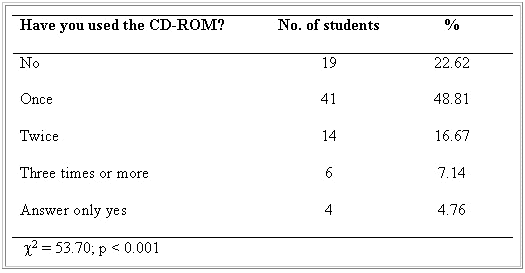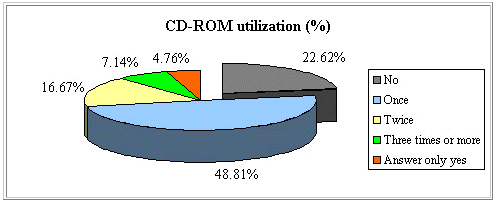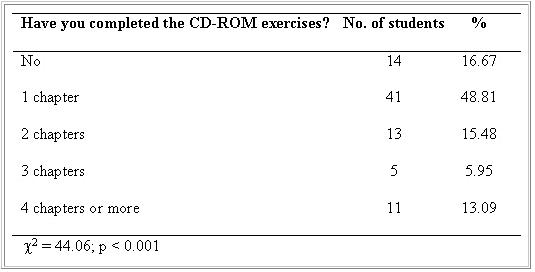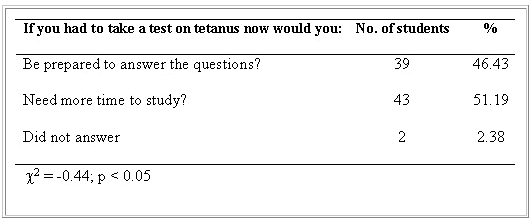Abstract
This study evaluated the impact of printed matter, video, and multimedia on the learning/teaching process in Tropical Diseases. Eighty-four of 90 fourth-year medical students at Botucatu School of Medicine of UNESP were evaluated. The students received a kit containing a textbook, a video, and a CD-ROM on the Clinical Study of Tetanus to prepare a seminar on the subject. They were then asked to complete a questionnaire, which led to the following conclusions: 67.86% read the textbook, 91.66% watched the video, and 77.38% explored the CD-ROM. These results were obtained observing the total number of students using each different media. When asked which of these media contributed most, the CD-ROM came out on top. The authors stress that this learning teaching process motivated the students by opening possibilities for new teaching alternatives in medicine.
medical education; tropical diseases; multimedia; video; printed matter
Original paper
EVALUATION OF THE IMPACT OF PRINTED MATTER, VIDEO, AND MULTIMEDIA ON THE LEARNING/TEACHING PROCESS IN TROPICAL DISEASES
M. F. SARMENTO E SOUZA1,3 CORRESPONDENCE TO:
M. F. SARMENTO E SOUZA - R. Cardoso de Almeida, 1431, CEP 18600-005, Botucatu, SP, Brasil
E-mail:
fsarmento@cevap.org.br
, A. CATANEO4, B. BARRAVIERA2,3
CORRESPONDENCE TO:
M. F. SARMENTO E SOUZA - R. Cardoso de Almeida, 1431, CEP 18600-005, Botucatu, SP, Brasil
E-mail:
fsarmento@cevap.org.br
, A. CATANEO4, B. BARRAVIERA2,3
1 Faculdade de Filosofia e Ciências, Universidade Estadual Paulista, Marília, SP, Brasil; 2 Departamento de Doenças Tropicais e Diagnóstico por Imagem, Faculdade de Medicina, Universidade Estadual Paulista, Botucatu, SP, Brasil; 3 Centro de Estudos de Venenos e Animais Peçonhentos, Universidade Estadual Paulista, Botucatu, SP, Brasil; 4 Departamento de Gestão e Tecnologia Agroindustrial, Faculdade de Ciências Agronômicas, Universidade Estadual Paulista, Botucatu, SP, Brasil.
ABSTRACT: This study evaluated the impact of printed matter, video, and multimedia on the learning/teaching process in Tropical Diseases. Eighty-four of 90 fourth-year medical students at Botucatu School of Medicine of UNESP were evaluated. The students received a kit containing a textbook, a video, and a CD-ROM on the Clinical Study of Tetanus to prepare a seminar on the subject. They were then asked to complete a questionnaire, which led to the following conclusions: 67.86% read the textbook, 91.66% watched the video, and 77.38% explored the CD-ROM. These results were obtained observing the total number of students using each different media. When asked which of these media contributed most, the CD-ROM came out on top. The authors stress that this learning teaching process motivated the students by opening possibilities for new teaching alternatives in medicine.
KEY WORDS: medical education, tropical diseases, multimedia, video, printed matter.
INTRODUCTION
Teaching and evaluation of medical courses have been a major concern in the Brazilian scientific community. Many factors are involved, including the information explosion in the areas of health. Today, the time required to disseminate information has become one of the major obstacles in medical education. Researchers involved in the learning/teaching process urgently need to develop new ways of teaching, using available communication resources. The objective of this study was to evaluate the impact of printed matter, video, and multimedia on the learning/teaching process in Tropical Diseases.
SUBJECTS AND METHODS
Subjects
Eighty-four of 90 fourth-year medical students at Botucatu School of Medicine of UNESP were evaluated while attending the course on Infectious and Parasitic Diseases I in 1999. This course is given to three groups of 30 students each.
In this study, 30 students were subdivided into 6 subgroups of 5 students each. All the subgroups were given a kit containing a textbook, a video, and a CD-ROM on the Clinical Study of Tetanus.
The textbook contains: the history, etiology, epidemiology, pathogenesis, clinical picture, diagnosis, treatment, and prophylaxis of tetanus. The book contains only texts without tables, figures, or diagrams.
The twenty-minute duration videotape also covers the same information as the textbook. The video was professionally produced, containing images of the diseases's history and of patients treated at the Tropical Diseases Clinic of Botucatu School of Medicine.
The CD-ROM also covers the same information but includes video clips, animations, and self-evaluation tests. The students are allowed to comment on the CD-ROM if they score better than 70% in these 160 tests.
Methods
Each subgroup received the kit one week prior to having to deliver an approximately 4-hour seminar. The students were advised to read the textbook, watch the video, and explore the CD-ROM, including completing the evaluation tests. Subgroup 1 presented the history and etiology; subgroup 2, epidemiology; subgroup 3, pathogenesis; subgroup 4, clinical picture; subgroup 5, diagnosis and prophylaxis; and subgroup 6, treatment. At the end of each presentation, the students were submitted to tests to assess what they had learned. Finally, the students filled in a questionnaire to evaluate the impact of the three media on their learning process.
Statistical analysis
The data were analyzed using the c2 test, assuming a null hypothesis that the distribution of answers were the same for each of the alternatives(9). A 5% significance level was used.
The Test of Proportions compared the video and CD-ROM with the textbook. This test for large samples was used because of the number of students(5). A 1% significance level was used.
RESULTS
All the c2 tests were significant for the significance level adopted showing that there may be a higher number of answers and some alternatives in all of the tables. Evaluation of the media impact were as follows:
1. Video: Seventy-seven students (91.66%) watched the video; of these, 52 (61.91%) saw it only once; 14 (16.67%) twice; and 5 (5.95%), three times or more. Seven students (8.33%) did not see it.
2. Textbook: Fifty-seven students (67.86%) read the textbook; of these 47 (55.96%) read it once; 3 (3.57%) twice; and 26 (30.95%) did not read it.
3. CD-ROM: Sixty-five students (77.38%) used the CD-ROM; of these 41 (48.81%) used it once; 14 (16.67%) twice; and 6 (7.14%) three times or more. Nineteen students (22.62%) did not use it.
4. CD-ROM exercises: Seventy students (83.33%) completed the CD-ROM exercises; of these 41 (48.81%) completed only 1 chapter; 13 (15.48%) completed 2 chapters; and 5 (5.95%) 3 chapters. Fourteen students (16.67%) did none of the exercises.
5. Studen evaluation of the media: When asked which media contributed most to their learning, 34 students (40.48%) replied: "the CD-ROM"; 20 (23.81%) "all three"; 12 (14.28%) "the video"; and 6 (7.14%) "the textbook."
6A. Evaluation tests: Sixty-four students (76.20%) found the CD-ROM of good quality.
6B. Mini-videos and animations: Sixty-nine students (82.15%) found the mini-video and animations of good quality. The students suggested that the CD-ROM should contain a more mini-videos and animations, since these contribute to their learning.
7. Student opinion: At the end of the questionnaire, the students were asked if they were prepared to take a test after the seminar. Thirty-nine students (46.43%) replied that they were prepared and 43 (51.19%) replied that they needed more time to study.
DISCUSSION
Teaching staff has always been concerned about the transmission of scientific information to their students. Time available for teaching has progressively been reduced. Teachers have to creatively find ways to transmit knowledge rapidly and objectively, attempting to maintain high student interest. Thus, the search for new teaching technologies using new communication resources is needed(1,2,3).
For the last 500 years, paper has been the standard medium for the transmission of knowledge. Printed matter is limited to texts, still unidimensional tables and colored images. For a good understanding of a scientific text, the reader has to use his imagination and create a favorable learning environment. Paper is undoubtedly the safest medium until now, but has several limitations related to presentation(1,8).
The explosive development of science in the past century has called for new ways of presenting information by using new audio and video resources. This last resource has allowed the introduction of movement, and when prepared professionally is a major teaching tool in medicine. Live images can be instantly captured in classrooms and operating theaters and transmitted immediately to interested parties in diverse locations.
In this study, video was the students' preferred media. This was probably chosen because they had to work in groups, and their gathering to watch a video was not only academic but social in nature. On the other hand, the video encourages a passive attitude on the part of the student and functions as a catalyst in discussions. The students also found that the subject's structured presentation on the video was an excellent tool in their studies. As well as presenting the subject succinctly and more superficially than the textbook and the CD-ROM, it presents a very comprehensive overview of the subject.
With the recent major developments in PC's and Internet content, new communication resources have been made available to the scientific community. The CD-ROM combines both text and visual resource and provides Web links(4,6,7).
A minimum utilization of any media does not predominate. Proportions of video and CD-ROM use do not differ from the textbook, which is used in traditional teaching.
In relation to total utilization, that is, the media being used one or more times, there is significant difference between the proportion of students using video and textbook.
With regard to media contribution to the learning process, both individual and combined use of media show significant differences between the proportions of students who believe the CD-ROM is more efficient than the textbook.
In this study, the students put the CD-ROM in second place. It encourages an active attitude on the part of the student, who has to be interested and motivated to explore it. According to the students, the CD-ROM was the medium that most contributed to their learning, since the didactically prepared images, video clips, and animations contributed to their understanding. Also, the comments provided on completion of the end-of-chapter tests helped them with their doubts. The CD-ROM allows its texts to be printed, includes videos, animations, and more recently, links to the Internet. These author-selected links have optimized the search process. Also, the well-produced pages prepared by both Brazilian and foreign authors are complementary and help motivate the learning process.
The authors stress that this learning process has been a great motivation to the students by introducing new teaching alternatives in medicine. Long-distance teaching, closely monitored by the teacher, may be a reality if an adequate and high-quality infrastructure is available. The possibility of home study at convenient times may become a reality thus reducing classroom time. Finally, the combined use of these media facilitates and speeds up the transmission of knowledge.
Received 25 September 2000
Accepted 06 June 2001
- 01. BARRAVIERA B. Editoração eletrônica científica. Botucatu: FUNDIBIO, 1997. 222p.
- 02. BARRAVIERA B. Estudo clínico dos acidentes ofídicos. Botucatu: Editora de Publicações Biomédicas, CD-ROM, 1999.
- 03. BARRAVIERA B. Tétano, uma atualização. Botucatu: Editora de Publicações Biomédicas, CD-ROM, 1998.
- 04. CHEN HS., GUO FR., LIU CT, LEE YJ., CHEN JH., LIN CC., HOU SM., HSIEH BS. Integrated medical informatics with small group teaching in medical education.Int. J. Med. Inform., 1998, 50: 59-68.
- 05. COSTA NETO PL. Estatística. São Paulo: Edgard Blücher, 1977. 264p.
- 06. PREMKUMAR K., HUNTER W., DAVISON J., JENNETT P. Development and validation of an evaluation tool for multimedia resources in health education. Int. J. Med. Inform., 1998, 50: 243-50.
- 07. SANTER DM., D'ALESSANDRO MP., HUNTLEY JS., ERKONEN WE, GALVIN JR. The multimedia textbook: a revolutionary tool for pediatric education.Arch. Pediatr. Adolesc. Med., 1994, 148: 711-5.
- 08. SANTER D.M., MICHAELSEN V.E., ERKONEN W.E., WINTER RJ., WOODHEAD JC., GILMER JS., D'ALESSANDRO MP., GALVIN JR. A comparison of educational interventions: multimedia textbook, standard lecture, and printed textbook. Arch. Pediatr. Adolesc. Med., 1995,149: 297-302.
- 09. SIEGEL S. Nonparametric Statistics for the behavioral sciences. Tokyo, McGraw-Hill, 1956. 312p.
Publication Dates
-
Publication in this collection
08 Oct 2002 -
Date of issue
Dec 2001
History
-
Accepted
06 June 2000 -
Received
25 Sept 2000



















